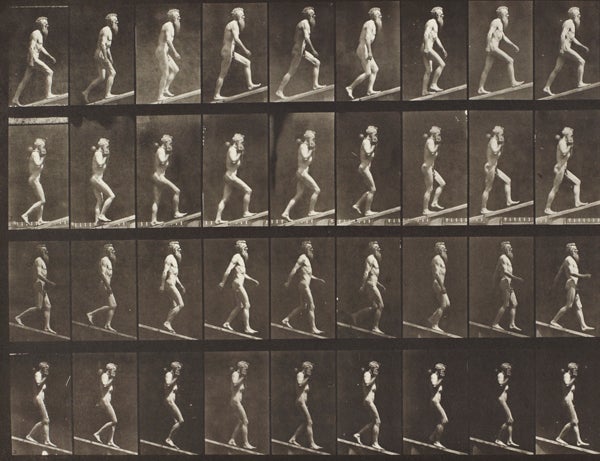|
October 5, 2011
Stanford exhibition spotlights Rodin's influence on America
Rodin was the most famous artist in the world in the last decades of his life – especially in America. A new exhibition shows his powerful influence on American modernism. By Cynthia Haven

Eadweard Muybridge's 'Turning Around in Surprise and Running Away' is among the works featured in the exhibit. (Photo: Courtesy of Cantor Arts Center) In the last few decades of his life, French sculptor Auguste Rodin took a young, brash America by storm.
The upstart nation was less fettered by stuffy conventions and outlooks – in art as in life. No wonder the nation was smitten by the high-energy, self-promoting genius.
The Cantor Arts Center's new exhibition celebrates that special relationship with Rodin and America: Influence and Adaptation, 1876-1936, opening Oct. 5 and continuing through Jan. 1. It is the first in-depth effort to investigate what America learned from Rodin and how his innovations shaped American modernism.
The exhibition includes not only pieces from the renowned Cantor collection but also sculptures, drawings, paintings and photographs by 42 artists from 44 museums, foundations and private collections throughout the United States. The exhibition also features 25 of Rodin's works in bronze, plaster, marble and watercolor.
Auguste Rodin (1840–1917) was the most famous artist in the world toward the end of his life – especially in America.
Bernard Barryte, Cantor's curator of American art, said that "nearly every American artist of this period had, at a minimum, a Rodin 'moment,'" including Georgia O'Keeffe, Gaston Lachaise and John Storrs, who eventually became famous after they moved beyond the maestro's influence.
Americans came to dominate the artistic circle around Rodin; they included artists, patrons and promoters. The hustle and bustle of America suited Rodin, who worked his way up from France's lower middle class. But that link has remained curiously unexamined till now.
Consider, by contrast, English author George Eliot's appraisal: she said that the artist produced "monstrosities, while remaining convinced . . . that he is creating masterpieces."
English critic Frederic Harrison described Rodin's groups as "morally and physically loathsome."
"Rodin's coarse types remain ugly brutes," he wrote.
In America, however, the middle-aged journalist and historian Henry Adams complained, "I have not enough vitality left to be sensual," but nonetheless looked forward to purchasing a Rodin bronze. He wrote to a friend: "They are mostly so sensually suggestive that I shall have to lock them up when any girls are about, which is awkward; but Rodin is the only degenerated [sic] artist I know of, whose work is original."
In view of the sensation he created, one can easily overlook the intensity and seriousness with which Rodin approached his art. He had a profound influence on a generation of American artists such as Malvina Hoffman, Lorado Taft, Gertrude Vanderbilt Whitney, Charles Demuth and photographers Edward Steichen and Alfred Stieglitz.
"In this period of radical transition, Rodin was a dominating figure. To some, he represented the decay of tradition; to others, he was the harbinger of the future. In either case, he could not be ignored," wrote Barryte in his introduction to the 380-page catalog that accompanies the exhibition.
"His presence had become pervasive, and the works themselves – so boldly sensual, so emotionally evocative, so dynamic in their structure, in short, so alive – must have seemed like a force of nature to which artists had to respond, whether by imitation, adaptation, or rejection," he wrote.
Sculptor Hoffman later wrote down Rodin's advice to her: "Promise me, Malvina, that you will never do sculpture to please or amuse – always be serious, thoughtful, responsible, for this is an art not to be played with."
Meanwhile, there were the strivers, two-timers and social climbers. Loïe Fuller, the American lead dancer at Paris' Folies Bergère, mixed promotion of Rodin with her own chronic need for money.
Claire Coudert de Choiseul, an American who had married the Duke de Choiseul, virtually usurped the artist's household. Gertrude Vanderbilt Whitney recalled her blocking young American sculptors from visiting with the words, "No use disturbing him since I am here. I handle everything. I am Rodin."
When her affair with Rodin ended in 1912, it made the front page of the New York Times.
She did, however, boost the artist's income from 60,000 to 400,000 francs a year. She also helped establish the Rodin collection and gallery at the Metropolitan Museum of Art in New York City.
That, of course, is a key contribution America made to Rodin's legacy: American collectors in Boston, New York, Chicago and San Francisco spread Rodin's influence in American art institutions. The Cantor Arts Center's flagship art collection of more than 200 works by Rodin represents the largest collection of Rodin bronzes outside of Paris, and it owes everything to two Americans: B. Gerald Cantor and Albert Elsen.
The Cantor Arts Center is open Wednesday through Sunday from 11 a.m. to 5 p.m., Thursday to 8 p.m. For museum information, call (650) 723-4177. Admission is free.
-30-
|